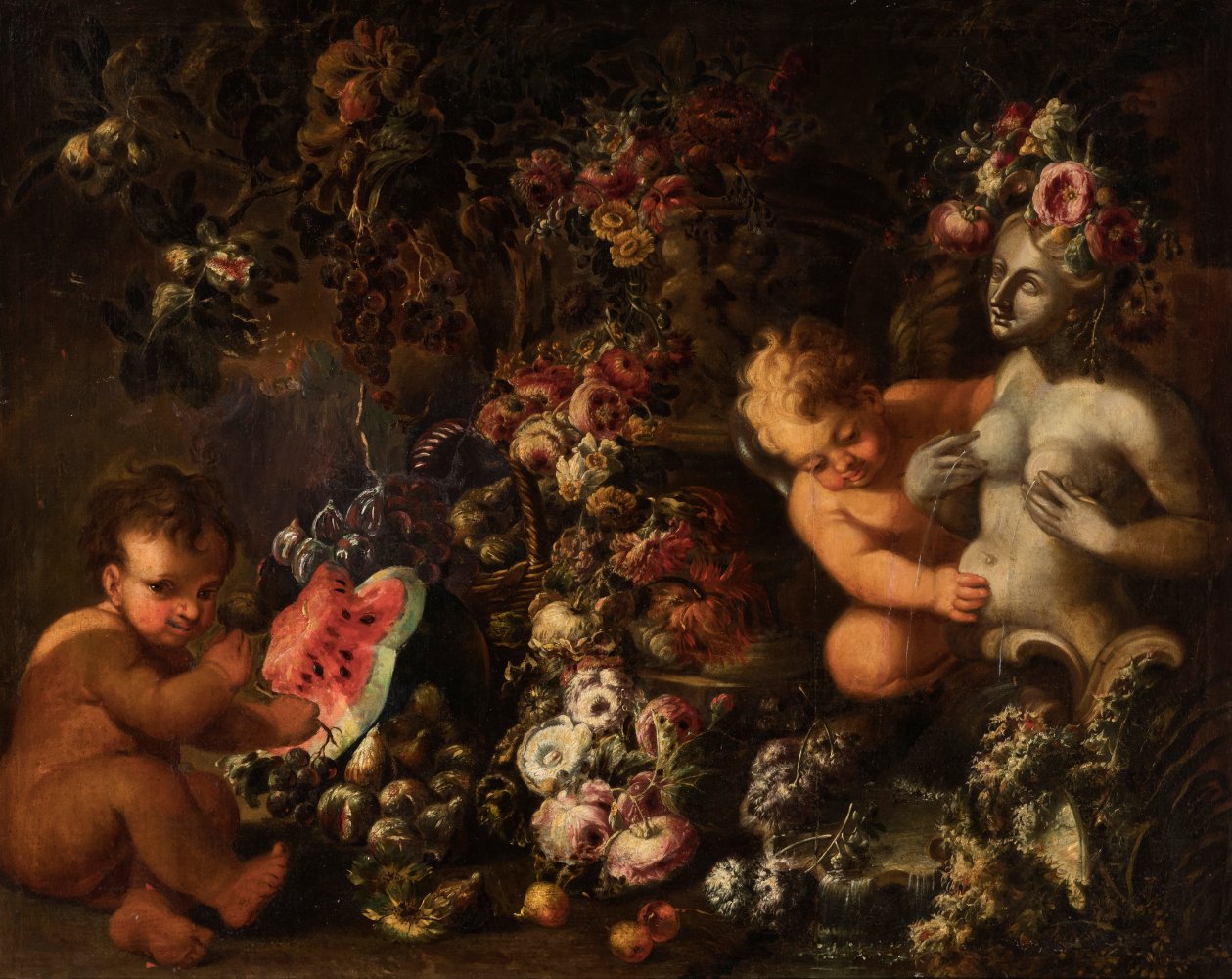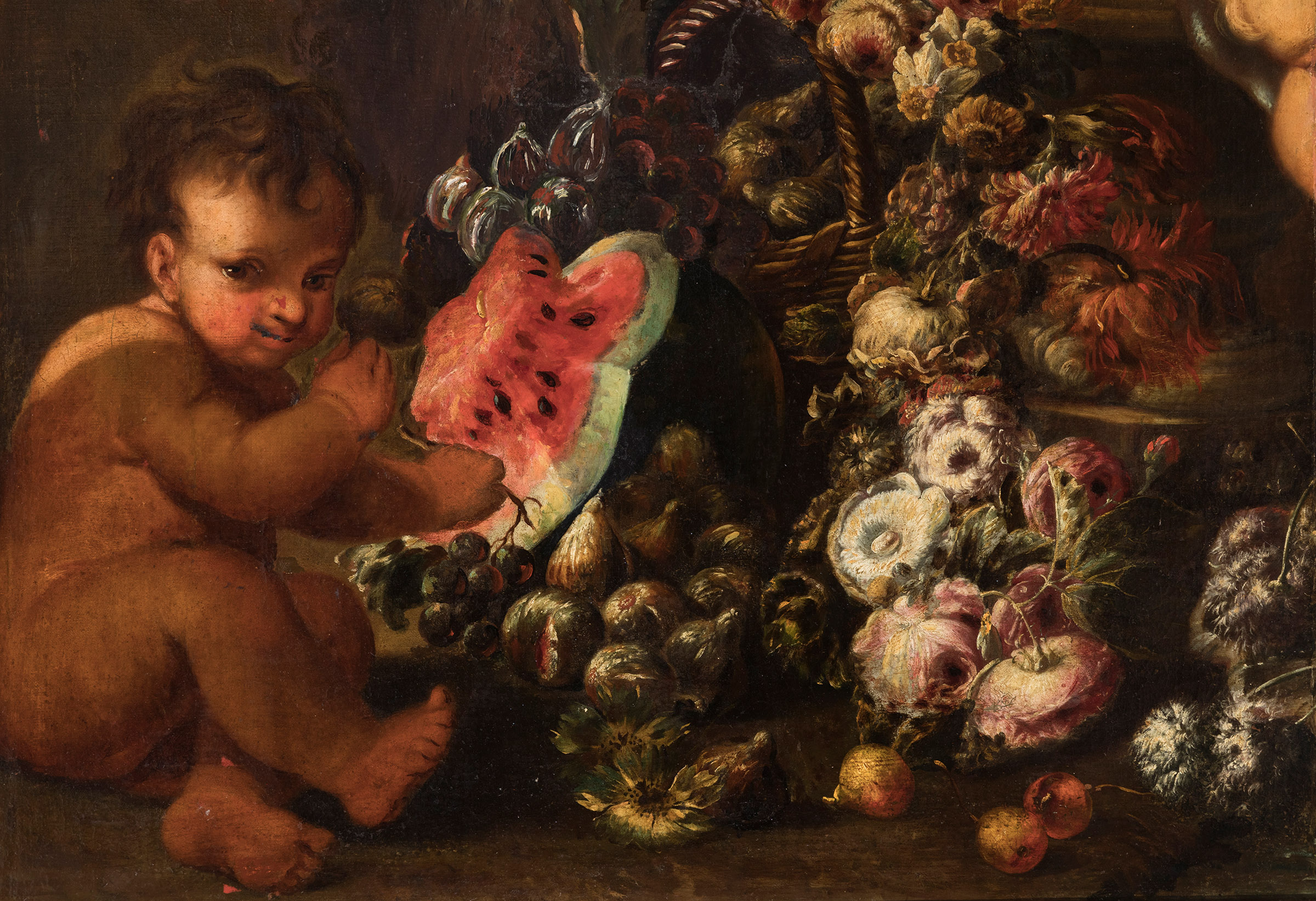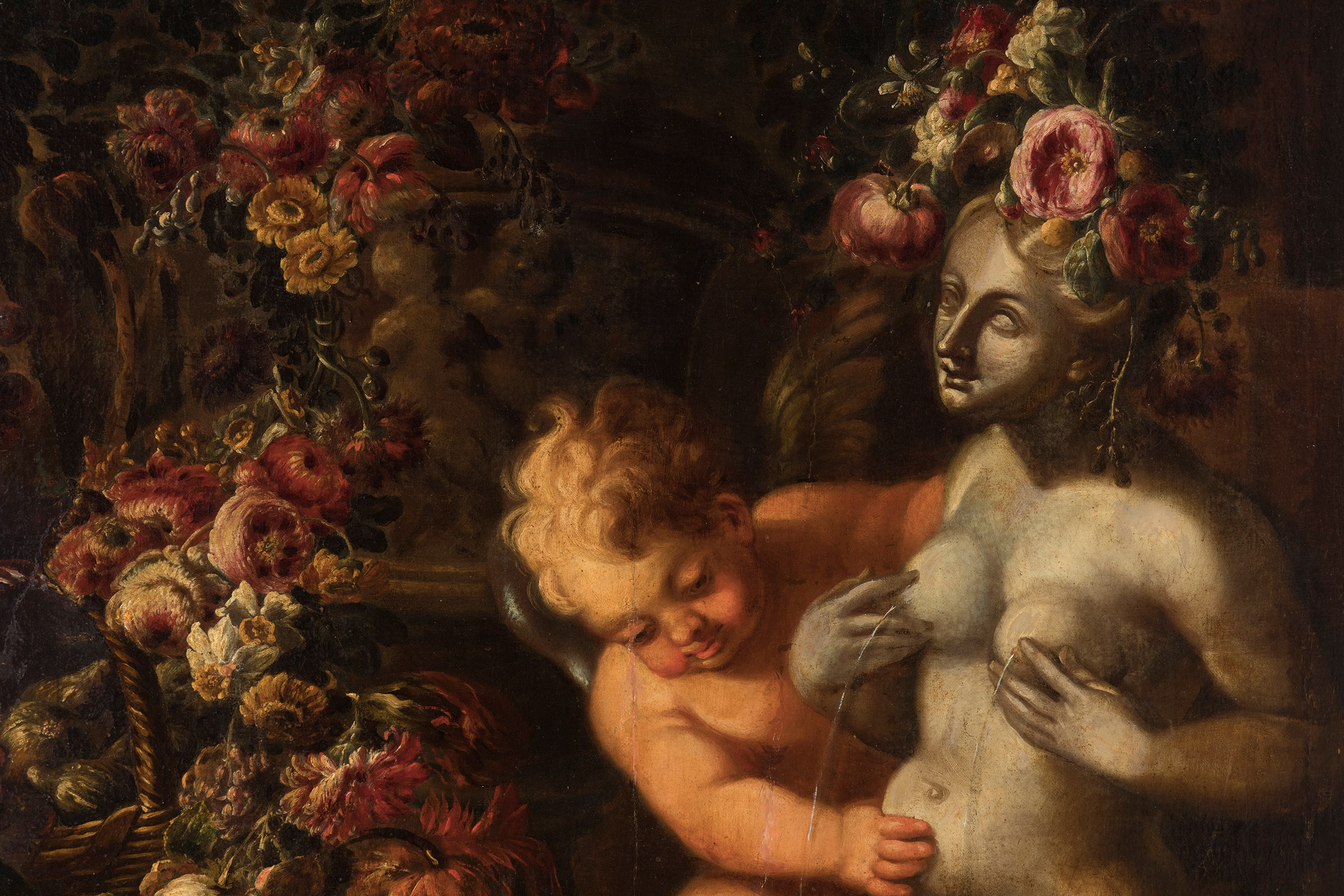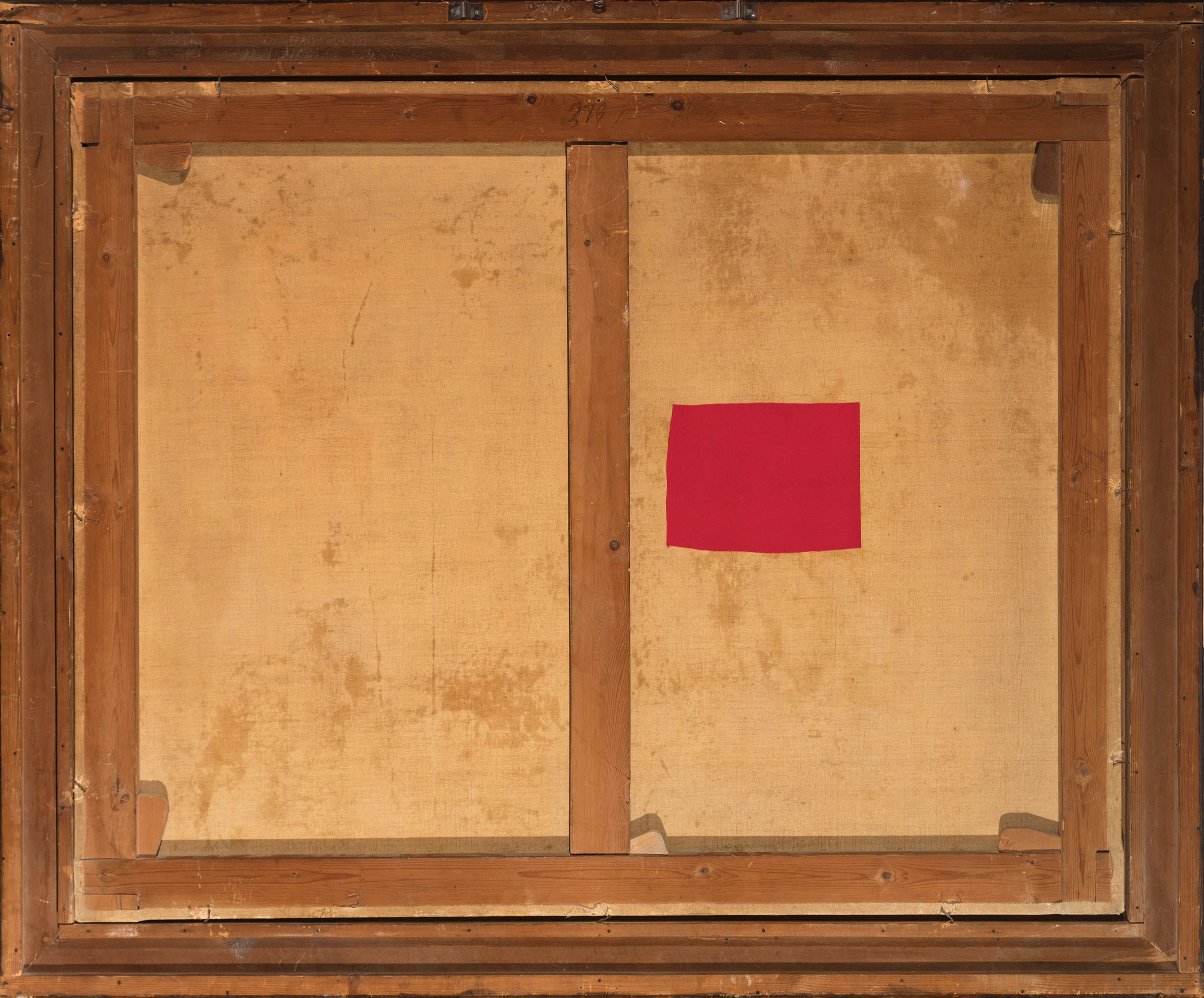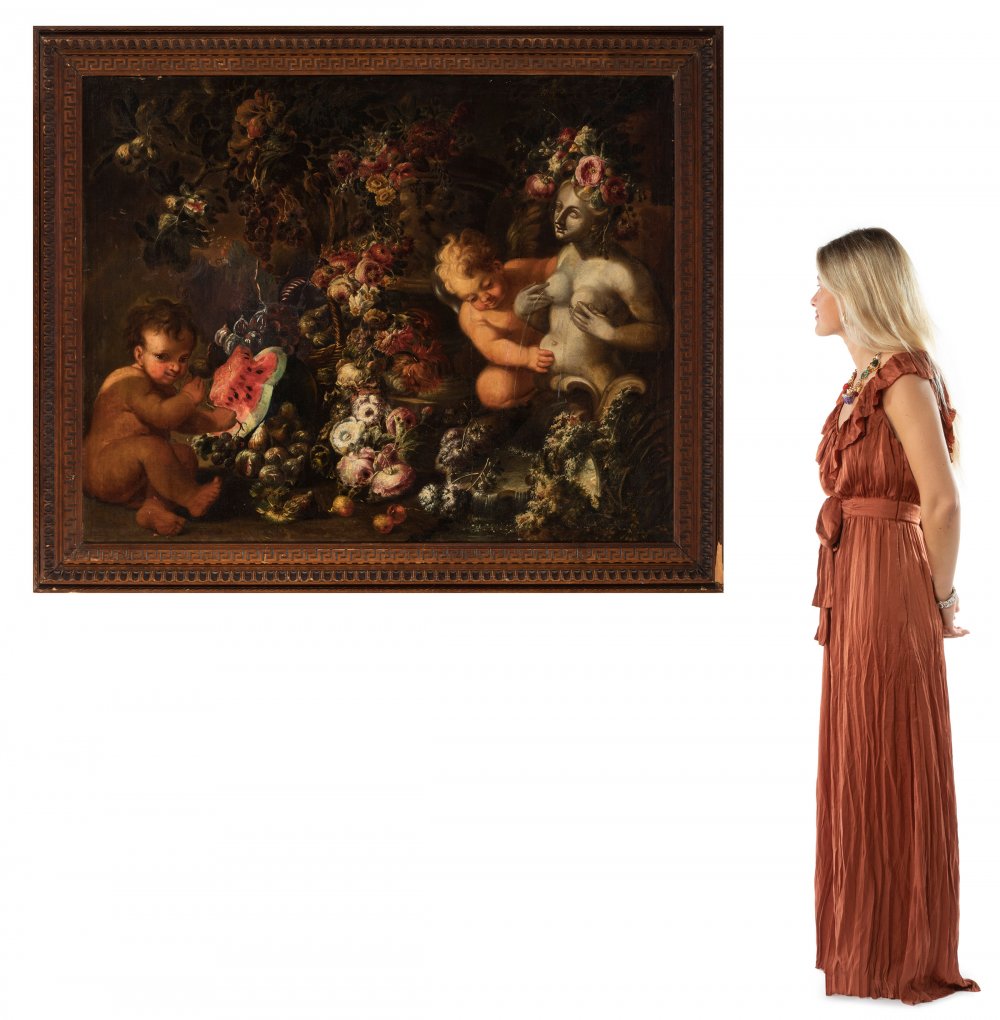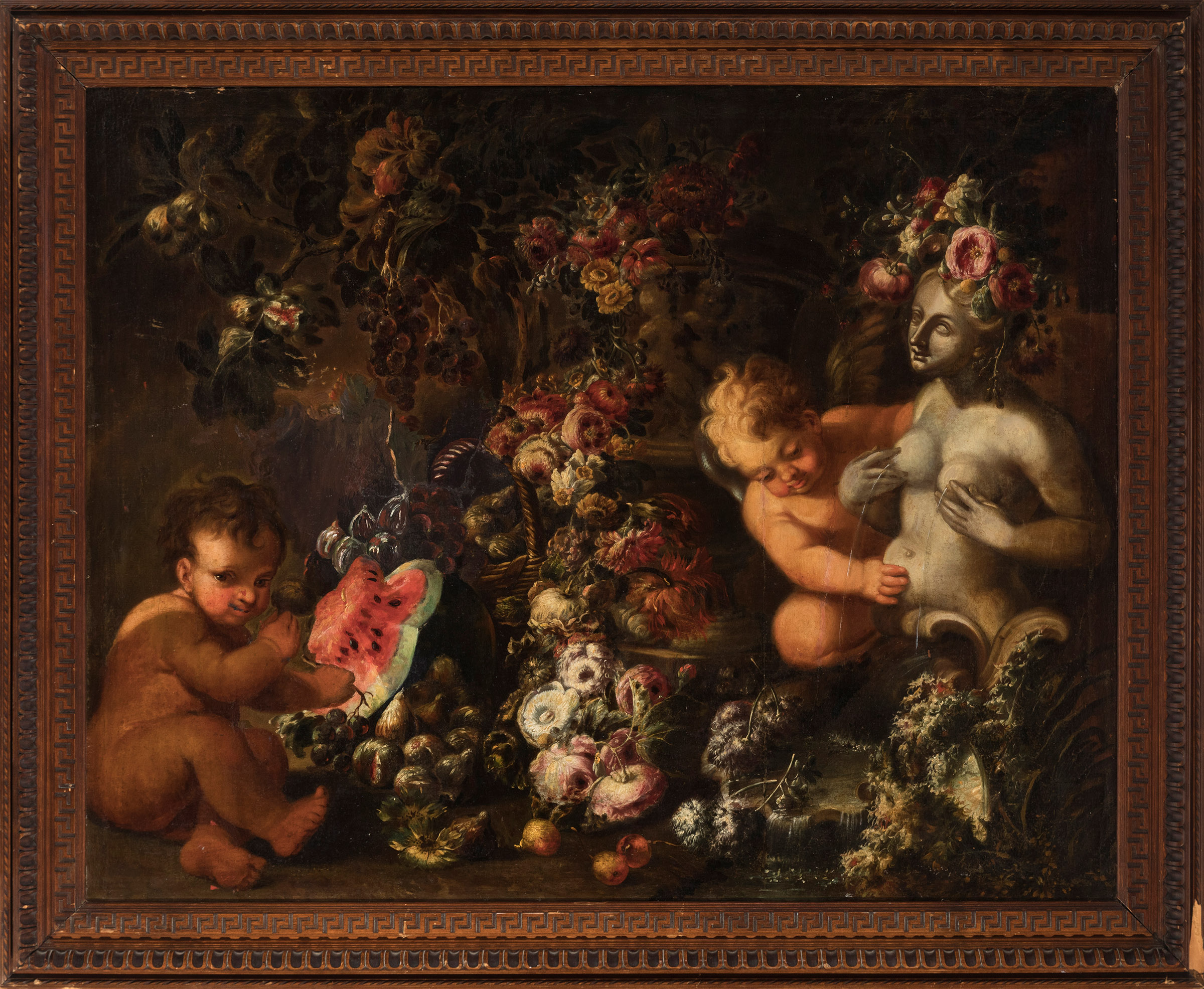10
ANDREA DEL BELVEDERE (Italy, ca. 1652-1732)."Still life".Oil on canvas. Re-coloured.With faults
1/7
Description
ANDREA DEL BELVEDERE (Italy, ca. 1652-1732).
"Still life".
Oil on canvas. Re-coloured.
With faults and repainting.
Frame of the 19th century.
Measurements: 100,5 x 126,5 cm; 121 x 147 cm (frame).
Andrea del Belvedere offers us a complex still life full of flowers and fruits magnificently worked, among which we can discern the figure of two putti and a classical sculpture. The elements of the still life are placed in the foreground in a typically baroque and dynamic composition. The movement is emphasised by the use of bright, metallic colours such as the pink of the children's flesh tones, the red of the watermelon and the grey of the sculpture, which in turn create a strong contrast with the rest of the tenebrist tones of the canvas, typical of Neapolitan still lifes.
Andrea del Belvedere was a Neapolitan painter who specialised in still lifes, principally of flowers. He was the last representative of what is known as the "Neapolitan still-life school", one of the most important still-life schools, highly appreciated in the antiquarian market, as well as among collectors and art historians. Little is known about the life of Andrea da Belvedere. It is thought that he trained with Paolo Porpora and Giovanni Battista Ruoppolo. Through northern influence he introduced greater complexity into his compositions, sometimes arranging his floral bouquets in front of rocky landscapes with animals or children's figures. His success took him to the Spanish court at the invitation of Luca Giordano, where he remained from 1694 to 1700. The Prado Museum and the Royal Palace of El Prado hold his work in their collections.
The Neapolitan still-life school of the Baroque enjoyed a spectacular development, leaving behind the splendour of the 16th century and progressing within a clearly identifiable, fully Baroque style. Artists such as Tommaso Realfonso, Nicola Casissa, Gaspare Lopez, Giacomo Nani and Baldassare de Caro continued the local tradition by specialising in the painting of flowers, fruit, fish and game, thus satisfying the demands of a vast clientele characterised by a new 17th-century taste. In addition to these artists, there are also the minor figures who are slowly emerging from an unjust oblivion, and some artists who worked between the 17th and 18th centuries, such as Francesco della Questa, Aniello Ascione, Nicola Malinconico, Gaetano Cusati, Onofrio Loth, Elena and Nicola Maria Recco, Giuseppe Ruoppolo and Andrea Belvedere. These Neapolitan still-life painters, who worked during the 17th and early 18th centuries, are known as "i generisti" and were important not only in their own environment but also, and especially, in Spain, where the development of the genre was clearly marked by Italian influence, particularly the contribution of the Neapolitan school. Today this school is considered one of the most outstanding within the Baroque still life genre. The distinguishing feature of Neapolitan Baroque painters was always their strong naturalistic character and their warm chromaticism, with a dominance of reddish and earthy tones.
"Still life".
Oil on canvas. Re-coloured.
With faults and repainting.
Frame of the 19th century.
Measurements: 100,5 x 126,5 cm; 121 x 147 cm (frame).
Andrea del Belvedere offers us a complex still life full of flowers and fruits magnificently worked, among which we can discern the figure of two putti and a classical sculpture. The elements of the still life are placed in the foreground in a typically baroque and dynamic composition. The movement is emphasised by the use of bright, metallic colours such as the pink of the children's flesh tones, the red of the watermelon and the grey of the sculpture, which in turn create a strong contrast with the rest of the tenebrist tones of the canvas, typical of Neapolitan still lifes.
Andrea del Belvedere was a Neapolitan painter who specialised in still lifes, principally of flowers. He was the last representative of what is known as the "Neapolitan still-life school", one of the most important still-life schools, highly appreciated in the antiquarian market, as well as among collectors and art historians. Little is known about the life of Andrea da Belvedere. It is thought that he trained with Paolo Porpora and Giovanni Battista Ruoppolo. Through northern influence he introduced greater complexity into his compositions, sometimes arranging his floral bouquets in front of rocky landscapes with animals or children's figures. His success took him to the Spanish court at the invitation of Luca Giordano, where he remained from 1694 to 1700. The Prado Museum and the Royal Palace of El Prado hold his work in their collections.
The Neapolitan still-life school of the Baroque enjoyed a spectacular development, leaving behind the splendour of the 16th century and progressing within a clearly identifiable, fully Baroque style. Artists such as Tommaso Realfonso, Nicola Casissa, Gaspare Lopez, Giacomo Nani and Baldassare de Caro continued the local tradition by specialising in the painting of flowers, fruit, fish and game, thus satisfying the demands of a vast clientele characterised by a new 17th-century taste. In addition to these artists, there are also the minor figures who are slowly emerging from an unjust oblivion, and some artists who worked between the 17th and 18th centuries, such as Francesco della Questa, Aniello Ascione, Nicola Malinconico, Gaetano Cusati, Onofrio Loth, Elena and Nicola Maria Recco, Giuseppe Ruoppolo and Andrea Belvedere. These Neapolitan still-life painters, who worked during the 17th and early 18th centuries, are known as "i generisti" and were important not only in their own environment but also, and especially, in Spain, where the development of the genre was clearly marked by Italian influence, particularly the contribution of the Neapolitan school. Today this school is considered one of the most outstanding within the Baroque still life genre. The distinguishing feature of Neapolitan Baroque painters was always their strong naturalistic character and their warm chromaticism, with a dominance of reddish and earthy tones.
Auction Details
Shipping
T&Cs & Important Info
Ask seller a question
ANDREA DEL BELVEDERE (Italy, ca. 1652-1732).
"Still life".
Oil on canvas. Re-coloured.
With faults and repainting.
Frame of the 19th century.
Measurements: 100,5 x 126,5 cm; 121 x 147 cm (frame).
Andrea del Belvedere offers us a complex still life full of flowers and fruits magnificently worked, among which we can discern the figure of two putti and a classical sculpture. The elements of the still life are placed in the foreground in a typically baroque and dynamic composition. The movement is emphasised by the use of bright, metallic colours such as the pink of the children's flesh tones, the red of the watermelon and the grey of the sculpture, which in turn create a strong contrast with the rest of the tenebrist tones of the canvas, typical of Neapolitan still lifes.
Andrea del Belvedere was a Neapolitan painter who specialised in still lifes, principally of flowers. He was the last representative of what is known as the "Neapolitan still-life school", one of the most important still-life schools, highly appreciated in the antiquarian market, as well as among collectors and art historians. Little is known about the life of Andrea da Belvedere. It is thought that he trained with Paolo Porpora and Giovanni Battista Ruoppolo. Through northern influence he introduced greater complexity into his compositions, sometimes arranging his floral bouquets in front of rocky landscapes with animals or children's figures. His success took him to the Spanish court at the invitation of Luca Giordano, where he remained from 1694 to 1700. The Prado Museum and the Royal Palace of El Prado hold his work in their collections.
The Neapolitan still-life school of the Baroque enjoyed a spectacular development, leaving behind the splendour of the 16th century and progressing within a clearly identifiable, fully Baroque style. Artists such as Tommaso Realfonso, Nicola Casissa, Gaspare Lopez, Giacomo Nani and Baldassare de Caro continued the local tradition by specialising in the painting of flowers, fruit, fish and game, thus satisfying the demands of a vast clientele characterised by a new 17th-century taste. In addition to these artists, there are also the minor figures who are slowly emerging from an unjust oblivion, and some artists who worked between the 17th and 18th centuries, such as Francesco della Questa, Aniello Ascione, Nicola Malinconico, Gaetano Cusati, Onofrio Loth, Elena and Nicola Maria Recco, Giuseppe Ruoppolo and Andrea Belvedere. These Neapolitan still-life painters, who worked during the 17th and early 18th centuries, are known as "i generisti" and were important not only in their own environment but also, and especially, in Spain, where the development of the genre was clearly marked by Italian influence, particularly the contribution of the Neapolitan school. Today this school is considered one of the most outstanding within the Baroque still life genre. The distinguishing feature of Neapolitan Baroque painters was always their strong naturalistic character and their warm chromaticism, with a dominance of reddish and earthy tones.
"Still life".
Oil on canvas. Re-coloured.
With faults and repainting.
Frame of the 19th century.
Measurements: 100,5 x 126,5 cm; 121 x 147 cm (frame).
Andrea del Belvedere offers us a complex still life full of flowers and fruits magnificently worked, among which we can discern the figure of two putti and a classical sculpture. The elements of the still life are placed in the foreground in a typically baroque and dynamic composition. The movement is emphasised by the use of bright, metallic colours such as the pink of the children's flesh tones, the red of the watermelon and the grey of the sculpture, which in turn create a strong contrast with the rest of the tenebrist tones of the canvas, typical of Neapolitan still lifes.
Andrea del Belvedere was a Neapolitan painter who specialised in still lifes, principally of flowers. He was the last representative of what is known as the "Neapolitan still-life school", one of the most important still-life schools, highly appreciated in the antiquarian market, as well as among collectors and art historians. Little is known about the life of Andrea da Belvedere. It is thought that he trained with Paolo Porpora and Giovanni Battista Ruoppolo. Through northern influence he introduced greater complexity into his compositions, sometimes arranging his floral bouquets in front of rocky landscapes with animals or children's figures. His success took him to the Spanish court at the invitation of Luca Giordano, where he remained from 1694 to 1700. The Prado Museum and the Royal Palace of El Prado hold his work in their collections.
The Neapolitan still-life school of the Baroque enjoyed a spectacular development, leaving behind the splendour of the 16th century and progressing within a clearly identifiable, fully Baroque style. Artists such as Tommaso Realfonso, Nicola Casissa, Gaspare Lopez, Giacomo Nani and Baldassare de Caro continued the local tradition by specialising in the painting of flowers, fruit, fish and game, thus satisfying the demands of a vast clientele characterised by a new 17th-century taste. In addition to these artists, there are also the minor figures who are slowly emerging from an unjust oblivion, and some artists who worked between the 17th and 18th centuries, such as Francesco della Questa, Aniello Ascione, Nicola Malinconico, Gaetano Cusati, Onofrio Loth, Elena and Nicola Maria Recco, Giuseppe Ruoppolo and Andrea Belvedere. These Neapolitan still-life painters, who worked during the 17th and early 18th centuries, are known as "i generisti" and were important not only in their own environment but also, and especially, in Spain, where the development of the genre was clearly marked by Italian influence, particularly the contribution of the Neapolitan school. Today this school is considered one of the most outstanding within the Baroque still life genre. The distinguishing feature of Neapolitan Baroque painters was always their strong naturalistic character and their warm chromaticism, with a dominance of reddish and earthy tones.
29th December - Old Masters
Sale Date(s)
Venue Address
Aragón 346, Barcelona
Calle Velázquez 7, Madrid
Carrer de Cirilo Amorós 55, Valencia
Barcelona
08009
Spain
General delivery information available from the auctioneer
Setdart offers Worldwide shipping
PICK UP IN ROOM: You can come and pick up your lots in our offices (Barcelona, Madrid or Valencia). At the moment of the withdrawal, you will be able to accept the current conditions of the lot by means of a document that you will sign.
YOU CAN SEND ANOTHER PERSON TO PICK UP: This person must present a signed authorization that you can find in our web page by accessing from BUY AT SETDART- LOGISTICS-DOWNLOAD AUTHORIZATION DOCUMENT. You can also send an e-mail with the requested data in AUTHORIZATION DOCUMENT to admin@setdart.com
Important Information
25% buyer´s premium
21% buyer´s premium at www.setdart.com















